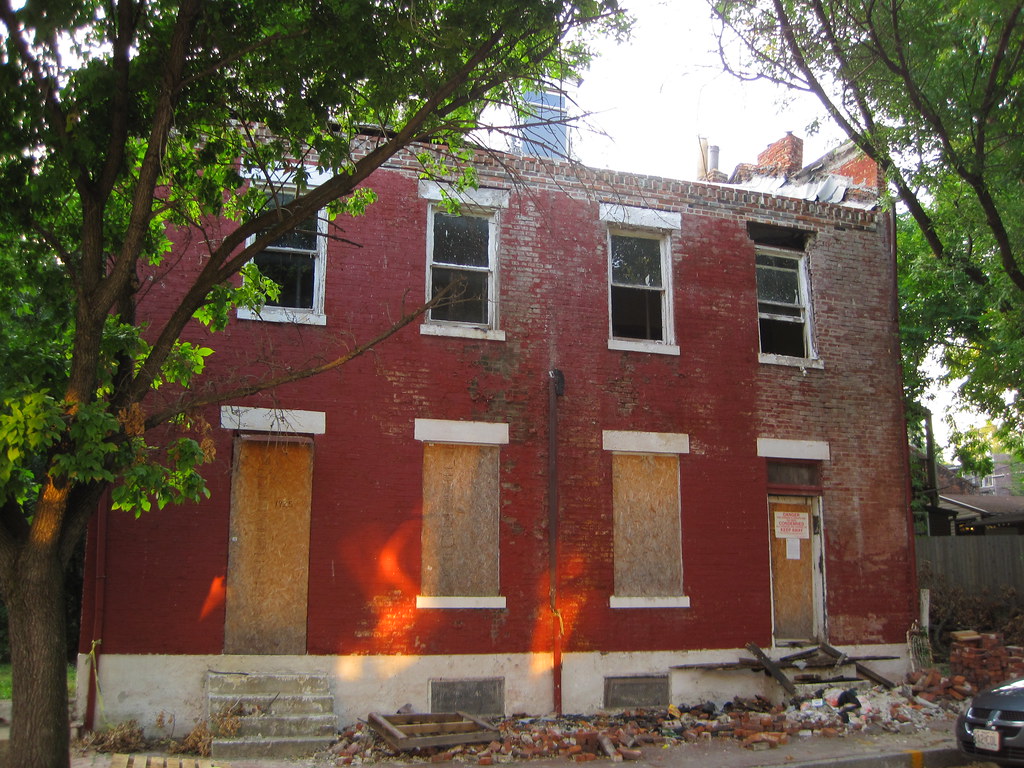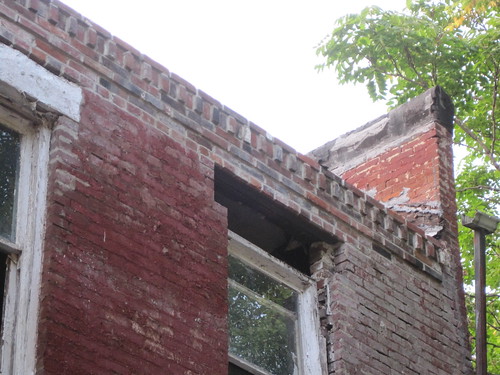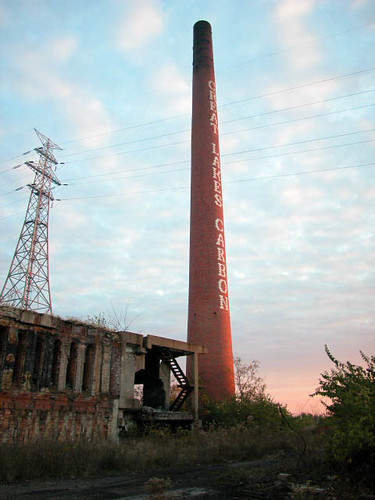 Now there is a rare opportunity: the chance to purchase the historic Stahl stables at 2414-16 Menard Street in Soulard and an adjacent house at 2412 Menard Street. Rehabilitated in the 1970s to house the St. Louis Architectural Art Company, the spacious stables consist of a rear building dating to 1866 and the front section, which dates to 1891. There are few comparable buildings in Soulard. The sale will benefit the current owner of the property, the non-profit St. Louis Building Arts Foundation. Read more about the buildings in the sale brochure.
Now there is a rare opportunity: the chance to purchase the historic Stahl stables at 2414-16 Menard Street in Soulard and an adjacent house at 2412 Menard Street. Rehabilitated in the 1970s to house the St. Louis Architectural Art Company, the spacious stables consist of a rear building dating to 1866 and the front section, which dates to 1891. There are few comparable buildings in Soulard. The sale will benefit the current owner of the property, the non-profit St. Louis Building Arts Foundation. Read more about the buildings in the sale brochure.
Category: South St. Louis
by Michael R. Allen

Photograph by Lynn M. Josse taken in 2000.
The 50th anniversary gala for Landmarks Association of St. Louis this past weekend took place at a venue called Palladium St. Louis but better known as the Laundry Building at the former City Hospital complex. Since 2003, Gilded Age Development has been working on rehabilitating the remaining buildings of the long-vacant municipal hospital. Thanks to the Butler’s Pantry, which built a new building next door for its headquarters, the Laundry Building is now complete.
Landmarks’ choice of venue for its half-century birthday was fitting; without an active preservation movement, City Hospital would not have survived nearly twenty years of abandonment to find new investment and new uses. There is another timely coincidence with the re-opening of the Laundry at this time. The National Register of Historic Places nomination for City Hospital by Lynn M. Josse reminds us that the Laundry Building was part of a Depression-era modernization of City Hospital funded by a combination of local and federal funds. Voters approved municipal bond issues in 1933 and 1934 to fund major expansion, and the Federal Emergency Administration of Public Works provided several matching grants. According to Josse, federal funds covered 45% of the costs of the 1939 round of construction that included the Laundry Building as well as a now-demolished 14-story hospital building. Albert Osburg, Chief Architect of the Board of Public Service, probably designed these new buildings.
The following photograph, taken by Dr. George W. Salmon, shows the corner of the newly-completed Laundry Building amid a modernized hospital complex and a dense, if smoky, metropolis.
 Public investment amid economic downtown led to the creation of the Laundry Building in the first place. The rebirth comes in a time when such public investment is viewed through an engrained, misplaced anti-government lense. However, Missouri’s state historic tax credit program — an incentive, of course, rather than a public investment — returned the Laundry Building to life. In this recession, St. Louis doesn’t have the impressive public investment of the New Deal era, but it does have a proven incentive that does a lot of good.
Public investment amid economic downtown led to the creation of the Laundry Building in the first place. The rebirth comes in a time when such public investment is viewed through an engrained, misplaced anti-government lense. However, Missouri’s state historic tax credit program — an incentive, of course, rather than a public investment — returned the Laundry Building to life. In this recession, St. Louis doesn’t have the impressive public investment of the New Deal era, but it does have a proven incentive that does a lot of good.
And what good has been done at the Laundry Building! Here’s a look at the changes using photographs that I took in 2004 and photographs taken this weekend after the gala.
 The two views above are looking west inside of the building. The two images below are aimed at the northwest corner. What a change! (The fate of that laundry machine is unknown.)
The two views above are looking west inside of the building. The two images below are aimed at the northwest corner. What a change! (The fate of that laundry machine is unknown.)
 As the photographs above show, the steel balcony running on the south and west walls remains in place. A lot of the glazed structural clay tile has been covered by drywall, but some exposed sections in the corners show off the lovely old walls. Some of those walls needed repair.
As the photographs above show, the steel balcony running on the south and west walls remains in place. A lot of the glazed structural clay tile has been covered by drywall, but some exposed sections in the corners show off the lovely old walls. Some of those walls needed repair.
 For years, the Laundry Building’s windows were boarded with ugly boards painted City-Owned Red. The cupola that echoes the cupolas of the Administration Building and Ward Wings on Lafayette Avenue was destroyed by thieve sin the 1980s. Now, the composition’s elegant strength is fully evident. Designed in the Georgian Revival style to blend with the rest of the historic hospital complex, the Laundry Building is really a functional modern box. Yet its architect gave this utilitarian building the dignity and hopeful beauty demanded by a city hospital building built amid a major national public works effort.
For years, the Laundry Building’s windows were boarded with ugly boards painted City-Owned Red. The cupola that echoes the cupolas of the Administration Building and Ward Wings on Lafayette Avenue was destroyed by thieve sin the 1980s. Now, the composition’s elegant strength is fully evident. Designed in the Georgian Revival style to blend with the rest of the historic hospital complex, the Laundry Building is really a functional modern box. Yet its architect gave this utilitarian building the dignity and hopeful beauty demanded by a city hospital building built amid a major national public works effort.
by Michael R. Allen
On September 16, the Keeper of the National Register of Historic Places listed the Grand-Bates Suburb Historic District in the National Register of Historic Places. The district encompasses the residential area roughly bounded by Grand Avenue on the west, Bates Avenue on the north, I-55 on the east and Iron Street on the south. the nomination was written by Andrew Weil, Research Associate for Landmarks Association of St. Louis and funded through the work of Alderman Matt Villa (D-11th).
Missing from the nomination is an area between Iron and Carondelet Park that could not be included due to the architectural gulf between it and the more consistent part of the district. Thus, landmarks like the Corinthian Baptist Church on Idaho Avenue (anchor of Carondelet’s historic African-American enclave), First District Police Station and the Seventh Church of Christ Scientist on Holly Hills Boulevard, the Southern Funeral Home on Grand Boulevard — all eligible for listing as single sites or as part of another district — are not covered. Hopefully they will get listed as well.
by Michael R. Allen
The city’s Cultural Resource Office (CRO) has published the final agenda for Monday’s Preservation Board meeting. CRO recommends that the Board uphold denial of the house at 1925-27 S. 10th Street in Soulard. The report clears up any doubt that Rehab Girls LLC is tied to developer Pete Rothschild. This action is inconsistent with Rothschild’s lauded track record on preservation.
by Michael R. Allen
 The most troubling item on the October 26 agenda for the St. Louis Preservation Board is the only actual demolition permit on the agenda, for a house at 1927-9 S. 10th Street in Soulard. While any demolition permit for a perfectly sound historic building is troubling, this one is egregious. For one thing, the two-and-a-half brick house is located in a dense and stable part of one of the city’s most dense and stable historic districts. For another, the house at 1927-9 S. 10th Street is one of the number of remaining St. Louis buildings that appear in the pages of Pictorial St. Louis, the 1875 atlas by Richard Compton and Camille Dry. The simple brick dentils on the cornice indicate an age even earlier than the atlas — perhaps in the 1850s or 1860s, before wooden cornices began appearing on modest housing like this. Such buildings are rare enough that the Preservation Board should never permit their demolition.
The most troubling item on the October 26 agenda for the St. Louis Preservation Board is the only actual demolition permit on the agenda, for a house at 1927-9 S. 10th Street in Soulard. While any demolition permit for a perfectly sound historic building is troubling, this one is egregious. For one thing, the two-and-a-half brick house is located in a dense and stable part of one of the city’s most dense and stable historic districts. For another, the house at 1927-9 S. 10th Street is one of the number of remaining St. Louis buildings that appear in the pages of Pictorial St. Louis, the 1875 atlas by Richard Compton and Camille Dry. The simple brick dentils on the cornice indicate an age even earlier than the atlas — perhaps in the 1850s or 1860s, before wooden cornices began appearing on modest housing like this. Such buildings are rare enough that the Preservation Board should never permit their demolition.
What this writer knows about the back story here provides little clue as to why the owner, Rehab Girls LLC, is pushing demolition. In its fictitious registration of the name Rehab Girls, Rehab Girls LLC — registered through a third-party registrar — reported that Peggy Sheffold is Vice President and that the company office is the same as Rothschild Development Ltd., Sheffold’s employer. Rothschild owns a lot of Soulard property, including a corner mixed-use building directly north of this house.
Rehab Girls LLC purchased the house on South 10th for $50,000 on December 19, 2006. Recently, the house was listed for sale by Red Brick Management, a Rothschild company, with a $136,000 asking price. Since the purchase, there are no recorded building permits despite a full recent reconstruction of the cornice.
 The work performed on the cornice indicates that the building’s brick work is fully repairable. Why Rehab Girls aborted the work and decided to pursue demolition is unfathomable. Soulard is a neighborhood that long has moved past dark days of demolition and on to significant infill construction. The “Rehab Girls” should stick to their name or sell this fine building. Meanwhile, the Preservation Board should deny the demolition request.
The work performed on the cornice indicates that the building’s brick work is fully repairable. Why Rehab Girls aborted the work and decided to pursue demolition is unfathomable. Soulard is a neighborhood that long has moved past dark days of demolition and on to significant infill construction. The “Rehab Girls” should stick to their name or sell this fine building. Meanwhile, the Preservation Board should deny the demolition request.
The Preservation Board meets at 4:00 p.m. on Monday, October 26 in the offices of the St. Louis Development Corporation, 1015 Locust Street, 12th floor.
However, citizens need not be present to submit written testimony. Testimony can be sent to the board via its secretary, Adona Buford, at BufordA@stlouiscity.com or care of the Cultural Resources Office, 1015 Locust Street, Suite 1200, St. Louis MO 63101.
by Michael R. Allen
Toenges Avenue has a three block run west of Carondelet Park. Its street faces are lined with the outstanding 20th century revival-style masonry architecture that prevails across the Holly Hills neighborhood. On Toenges, as with each of the city’s streets, the saying that no two houses in St. Louis are completely alike rings true. Want proof for the saying? Take your pick from ten thousand examples.
 Today’s proof are near-twin houses on the north side of Toenges between Ray and Leona. Shown above is the two-story house at 4079 Toenges, built in 1928. The wide eclectic net of Craftsman practice in St. Louis was cast upon this dwelling, producing a marvelously lop-sided gable and a finely-detailed front chimney. In fact, sight of that chimney caused this writer to take the photograph shown here. (I was out in the field on a subcontractor assignment, surveying garages in the area of Holly Hills north of Holly Hills Avenue.)
Today’s proof are near-twin houses on the north side of Toenges between Ray and Leona. Shown above is the two-story house at 4079 Toenges, built in 1928. The wide eclectic net of Craftsman practice in St. Louis was cast upon this dwelling, producing a marvelously lop-sided gable and a finely-detailed front chimney. In fact, sight of that chimney caused this writer to take the photograph shown here. (I was out in the field on a subcontractor assignment, surveying garages in the area of Holly Hills north of Holly Hills Avenue.)
The step, shed rise of the chimney is made even more lovely by the red brick trace course against the ochre brick body. That same rise pattern repeats on the buttress at left, except only the shed bricks are in red. Then the red segmental arches and earmolds above each window play a trick on the first floor, where unlike the second floor tried-and-true arch profile the arches are set within a square-cornered head. Delightfully strange, to be sure!
 Back to the premise of the no-two-houses saying. Just a few doors east is the house at 4071 Toenges, also dating to 1928 and nearly identical to the other house. Of course, the fenestration, roof line and side buttress are copied, but little of the detailing is similar. (The false stone porch cladding is nor original, by the way.) The brick body is a robust brown, with none of the dazzling drama of the ochre and red contrast. The biggest difference is that the chimney profile here is a simple shed-slant style, with no stepped rise.
Back to the premise of the no-two-houses saying. Just a few doors east is the house at 4071 Toenges, also dating to 1928 and nearly identical to the other house. Of course, the fenestration, roof line and side buttress are copied, but little of the detailing is similar. (The false stone porch cladding is nor original, by the way.) The brick body is a robust brown, with none of the dazzling drama of the ochre and red contrast. The biggest difference is that the chimney profile here is a simple shed-slant style, with no stepped rise.
Two houses — so close and yet so distinctly unique! Ah, but in St. Louis this relationship is not news, so forgive this writer for taking your time on just one of thousands of such discoveries across our built environment.
by Michael R. Allen
 The U.S.S. Inaugural remains a fixture on the St. Louis riverfront, just south of the MacArthur Bridge. Since breaking loose from its moorings and capsizing in a bizarre incident during the great flood of 1993, the old minesweeper has been stuck on the riverfront. After spending a generation as a tourist attraction, the war vessel has become part of the lore of local urban explorers — and the subject of many schemes to profit from the tragedy.
The U.S.S. Inaugural remains a fixture on the St. Louis riverfront, just south of the MacArthur Bridge. Since breaking loose from its moorings and capsizing in a bizarre incident during the great flood of 1993, the old minesweeper has been stuck on the riverfront. After spending a generation as a tourist attraction, the war vessel has become part of the lore of local urban explorers — and the subject of many schemes to profit from the tragedy.
The ship’s remains are almost too easy to find, located just a short walk through a gate in the flood wall. On a sunny Indian summer day, the wreck conveys a sense of tranquility. Later, in the winter, when the water gets lower the ship will beckon explorers. John Patzius has held the salvage rights to the boat since 1998, and had attempted to move the Inaugural out of the river. The mighty gun from the bow of the Inagural is located at Bob Cassilly’s Cementland; that relocation by Patzius is theft by his own admission (although rightful theft, by his judgment). Future plans remain unknown. For now, the wreck is a splendid landmark to behold on a weekend ramble. Some days one will find artists hard at work creating murals on the flood wall, almost always atop the work of others. Inexplicably, no one has ever tagged the wreck just a few yards away. (Red Foxx, are you reading?)
More information is available in the U.S.S. Inaugural Online Scrapbook.
by Michael R. Allen
Today’s Preservation Board agenda contains an interesting preliminary review: the Cultural Resources Office (CRO) has jurisdiction over a poorly-conceived streamline modern industrial building at 4110 Beck Avenue due to review jurisdiction of encroachments in the public right of way. The false pilasters proposed to be added are encroachments, and CRO recommends denial.
The other changes, some also out of character, don’t fall under the CRO’s review powers and cannot be considered. Read the item here.
UPDATE: This matter was not on the final agenda.
by Michael R. Allen
Today Mayor Francis Slay and Governor Jay Nixon will hold a join press conference announcing a new plan to convert the 41-acre, city-owned Carondelet Coke Plant into an industrial park. Summit Development announced a similar plan in 2006, but the plan stalled after some initial work was done on the site — including bringing in a giant mound of containment soil.
I have published a basic history of the site and documented the buildings over the years. However, I never expected the buildings to be preserved. The site is contaminated widely with many substances related to the coke production process, which began at the site in 1915.
Still, there are two resources on the site whose preservation would require minimal loss of usable site and whose presence would provide the new industrial park with readily-identified icons. Given that the coke plant was one of the largest employers in the Patch section of Carondelet for over 60 years, some tangible link with the industrial past is fitting. Thousands of area residents worked at the plant, enduring the emission-laden landscape to support their families. Why not allow future generations the chance to see something when they visit the site where a grandfather or great-grandfather once worked?
 The most obvious resources to preserve is the remaining brick smokestack, which stands at the south end of the coke oven battery. This was one of two stacks that relieved the smoke from the ovens. This stack dates to the ownership period of Great Lakes Carbon Company, which owned the plant from 1950 through 1980. Being constructed of modern brick within the past 60 years, it is in sound condition and requires minimal tuckpointing to survive another 100 years. Perhaps the stack could sit in a small public area with interpretive signage and photographs so that people can interact with the site history.
The most obvious resources to preserve is the remaining brick smokestack, which stands at the south end of the coke oven battery. This was one of two stacks that relieved the smoke from the ovens. This stack dates to the ownership period of Great Lakes Carbon Company, which owned the plant from 1950 through 1980. Being constructed of modern brick within the past 60 years, it is in sound condition and requires minimal tuckpointing to survive another 100 years. Perhaps the stack could sit in a small public area with interpretive signage and photographs so that people can interact with the site history.
 The other structure is visible only from the Mississippi River and also dates to the Great Lakes ownership period. This mighty steel coal loader dates to 1953 and was used to unload barge loads of coal arriving at the plant as well as to load outgoing barges with coke. The loader connects to the coke plant by an underground conveyor system. The basic structure is sound, although years of abandonment have led to rust and some deterioration of deck plating. There are few extant 20th century river side coal loaders in St. Louis.
The other structure is visible only from the Mississippi River and also dates to the Great Lakes ownership period. This mighty steel coal loader dates to 1953 and was used to unload barge loads of coal arriving at the plant as well as to load outgoing barges with coke. The loader connects to the coke plant by an underground conveyor system. The basic structure is sound, although years of abandonment have led to rust and some deterioration of deck plating. There are few extant 20th century river side coal loaders in St. Louis.
I have marked the locations of each structure on this circa-1950 aerial view of the coke plant. Most of the remaining plant has been wrecked. The buildings literally are now ruins after being slowly and possible illegally demolished in the past two years.

Tying the new industrial life of the site to its past would preserve the tie of this site to the Carondelet community through a physical link. Our industrial past too often disappears through alteration and demolition, and in many cases active industrial sites leave behind few photographs of their historic life. Here we can leave some key parts of the past behind for future generations to contemplate.
Additionally, the Great Rivers Greenway District is discussing building a south trail system that would include Sugar Loaf Mound and run along the riverfront. Could the trail pass south to an industrial heritage site at Carondelet Coke? Joliet, Illinois has a lovely trail system that connects to Joliet Iron Works Park, an interpretive and recreational site that incorporates the ruins of the Joliet Iron and Steel Works. That site is a destination. Imagine if one could travel on a river side trail that linked a Native American mound with a river side coal loader, right here in St. Louis.
by Michael R. Allen
 The Avalon Theater at 4225 S. Kingshighway is sporting a for-sale sign for the first time since it closed in 1998. Why didn’t this sign go up years ago, before much of the deterioration started? Well, the City of St. Louis was not trying to gain trusteeship over the defunct Sopo Corporation that owns the Avalon. On May 11, the City Counselor’s Office filed suit against the corporation seeking to have the city appointed trustee to dissolve the corporation’s assets — namely, the Avalon Theater. The next hearing is scheduled for September 14 before Judge Robert Dierker, Jr.
The Avalon Theater at 4225 S. Kingshighway is sporting a for-sale sign for the first time since it closed in 1998. Why didn’t this sign go up years ago, before much of the deterioration started? Well, the City of St. Louis was not trying to gain trusteeship over the defunct Sopo Corporation that owns the Avalon. On May 11, the City Counselor’s Office filed suit against the corporation seeking to have the city appointed trustee to dissolve the corporation’s assets — namely, the Avalon Theater. The next hearing is scheduled for September 14 before Judge Robert Dierker, Jr.
For years, Greg Tsevis has acted as owner of the theater, and has told people that the historic neighborhood theater is for sale at prices ranging from $1 million to $2 million. The trouble is that Tsevis’ parents never appointed successor trustees to their corporation before passing away, meaning that Tsevis technically not the owner.
The listing price is familiar: $1 million. How valid would a sales contract with Sopo Corporation be? That’s a good question, but the high listing price almost certainly guarantees that question won’t be asked.



